The Last Days of the Incas’ Peru Tour #9 (Cusco)
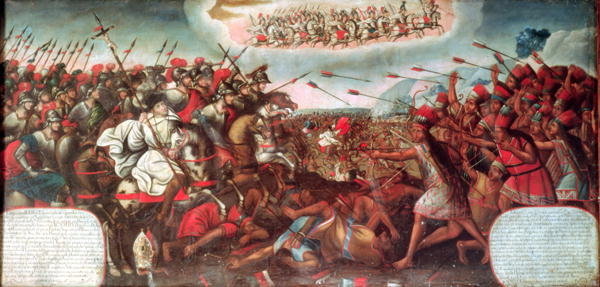
The Last Days Of The Incas Battle Scene
Cusco (3-4 Days)
Visiting La Merced Monastery and Church
(Burial site of Diego de Almagro Sr, Diego de Almagro Jr, and Gonzalo Pizarro. Repository of the painting (above) that adorns the cover of The Last Days of the Incas)
Just a block to the southwest of the Plaza de Armas (which makes three major churches in a three-block radius!) lies La Merced Monastery and Church, begun in 1534 and rebuilt in the late 17th century. The monastery (to the left of the church) is one of the little-known jewels of Cusco and is beautifully designed around a central garden and courtyard. The arcades around the garden are surprisingly hung with a large number of “Cusco-school”-style paintings of very high quality. The first painting on the left, in fact, as you enter the monastery, is the same painting that adorns the (U.S. and Canadian version) cover of The Last Days of the Incas. It actually depicts armored Spaniards on horseback fighting the fierce Araucanian Indians in central Chile, who resisted Spanish attempts to conquer them for centuries. On one of the horses rides a white-robed Mercedarian friar carrying a lance–one end of which bears a metal crucifix. Above him, the Spanish patron Saint Santiago, whom the Spaniards often invoked during their pitched battles against various natives in South America, is performing a miracle—turning the Araucanians’ arrows back upon themselves. On the far side of the cloister you’ll find a small art museum. Within it (and outside on the cloister’s walls) is the best collection of Cusco-school paintings in the world…
(more…)
The Last Days of the Incas’ Peru Tour #8 (Cusco)
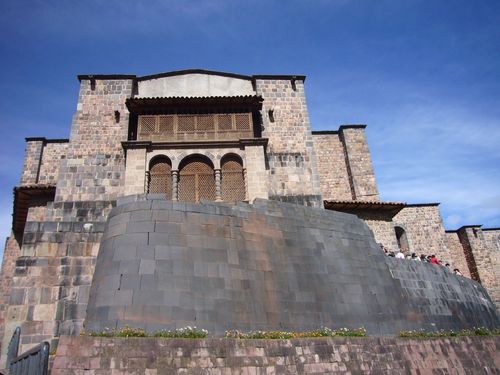
Cusco (3-4 Days)
Visiting the Qoricancha, or Inca Temple of the Sun
Two long blocks southeast of Cusco’s Plaza de Armas stands the church of Santo Domingo and below it, the Inca’s most sacred temple, the Qoricancha, or temple of the sun. When the first three Spaniards Pizarro had sent to Cusco arrived, they found the Incas’ sun temple gleaming literally like gold. With Pizarro still holding the Inca emperor Atahualpa hostage in northern Peru, the Inca general in charge of the city, General Quisquis, found himself forced to comply with Atahualpa’s orders to help the three Spaniards loot gold and silver from the capital.
Quoting from Chapter 5 of The Last Days of the Incas:
“What had really caught the trio’s attention, however, from the moment they had looked down upon the capital after crossing the final crest of hills, were certain buildings that seemed to burn as brightly as the sun, as if the buildings themselves had been dipped into a golden fire. After some investigation, they discovered that, sure enough, “These buildings were sheathed on the side where the sun rises with large plates of gold…They said there was so much gold in all the buildings of the city that it was a marvelous thing…[and that] they would have brought much more of it if this would not have detained them longer, because they were alone and over 250 leagues from the other Christians….”
(more…)
The Last Days of the Incas’ Peru Tour #7 (Cusco)
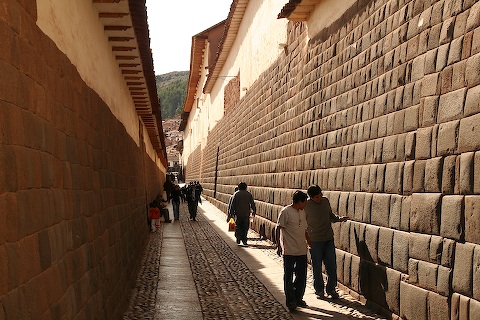
Cusco (3-4 Days)
Visiting the Location where Diego de Almagro Captured Hernando and Gonazalo Pizarro During Almagro’s Seizure of Cusco in 1537
(Above: Loreto Street in Cusco; on the left is the wall of the Inca palace known as the Amaru Cancha.On the right is the outside wall of the Acclawasi, or the temple of the “Chosen Women”).
It was in 1537, shortly after Manco Inca lifted his siege of Cusco, on the southeastern portion of Cusco’s Plaza de Armas, where Hernando Pizarro, his brother Gonzalo, and about twenty followers were seized by Diego de Almagro—the first in a chain of incidents that would lead to a deadly civil war. The Pizarros had holed up in Huayna Capac’s former palace of Amaru Cancha in 1537, just as Diego de Almagro, Pizarro’s former partner, had returned from Chile. Much of the site is now occupied by the Jesuit church, La Compañía; however, some of the wall of the Amaru Cancha can still be seen on the eastern side of Loreto Street, that runs from the southeastern part of the square (Amaru Cancha, in the Incas’ language, Quechua, means “Snake House” or “House of the Serpents”; the snake among the Incas was a symbol of knowledge and learning, a stone with a carved snake can still be seen along Calle Loreto, on one of the Amaru Cancha’s walls)…
(more…)
The Last Days of the Incas’ Peru Tour #6 (Cusco)
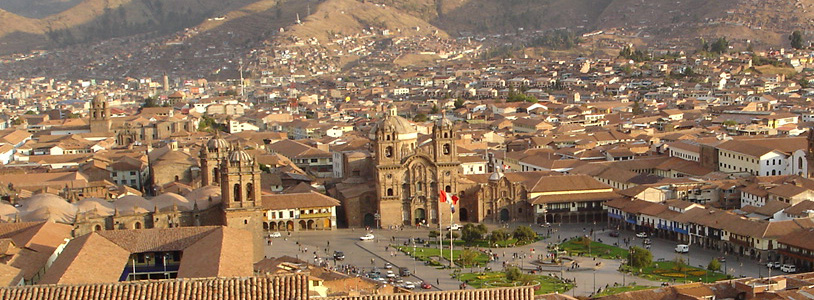
Cusco (3-4 Days)
Visiting Cusco’s Plaza de Armas, or Main Square
On November 15, 1533, Francisco Pizarro and his men arrived in the city of Cusco, after skirmishing with an Inca army to the north of the city, but which during the night had withdrawn. Pizarro and his men thus walked unopposed into the city, and bivouacked on the main square. The square, twice the size of the present one now, was lined with the palaces of former Inca Emperors and these were quickly seized by Pizarro and his top captains as residences.
The original Inca square was divided in the middle by the Saphi River, which now runs beneath the buildings on the southwest side of the square (the portals of which are called Portal de Comercio and Portal de Confituría). The rest of the Inca square was partially comprised by what is now known as the Plaza Recogio, which lies a block to the west.
Locations of the Conquistadors’ and Inca Emperors’ Palaces
On the northwestern corner of the Plaza de Armas once stood the Casana, presumably one of the palaces of the last Inca emperor to rule over an undivided empire: Huayna Capac, the father of the two warring brothers, Atahualpa and Huascar, and also of Manco Inca and Paullu Inca. Francisco Pizarro quickly selected this palace to reside in and a corner of the palace still remains, part of what is currently the Pachacutec Bar & Grill…
(more…)
The Last Days of the Incas’ Peru Tour #5 (Cusco)
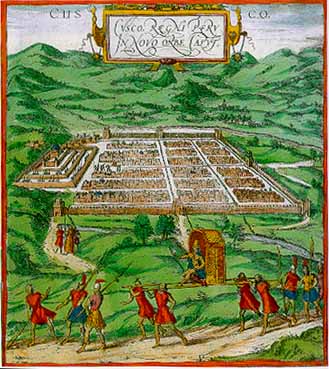
Cusco (3-4 days)
The Arrival of the first Spaniards in Cusco
In 1533, while Francisco Pizarro and his men held the Inca Emperor Atahualpa hostage for a ransom of gold in the north of Peru in Cajamarca, Pizarro sent three of his men—a Basque notary and two former sailors—600 miles southwards to Cusco, a city the Spaniards had only heard about but which they had been assured held vast quantities of gold. Pizarrro’s instructions to his men were to “take possession” of the city for the Spanish crown, and to help expedite the collection of gold and silver for Atahualpa’s ransom. The two sailors and the notary were thus the first Europeans to be carried in royal Inca litters along the spine of the Andes and were also the first Europeans as well to view and enter the Incas’ capital.
Quoting from chapter 5 of The Last Days of the Incas, this is some of what they saw:
“The small procession soon headed south from Cajamarca, climbing the flanks of fantastic mountains, cutting past pale, blue-green glaciers, crossing through Inca cities and villages set besides rivers that sparkled in the sun, then traversing giant gorges on hanging Inca bridges while witnessing vast flocks of llamas and alpacas that seemed to extend for as far as the eye could see. Strangers in a strange land, these were the first Europeans to witness an untouched Andean world never before seen, one with a thriving native civilization in all of its color and scarcely understood complexity. Everything was new—plants, animals, people, villages, mountains, herds, languages, and cities. A trio of Marco Polos adrift in the New World, they were similarly off to seek riches in a distant and fabled city….
(more…)
The Last Days of the Incas’ Peru Tour #4 (Lima)
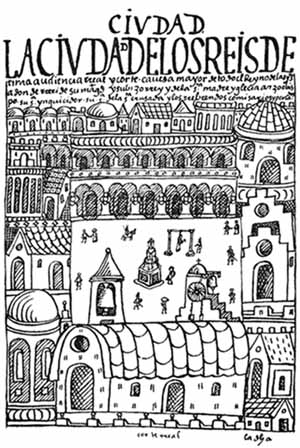
Lima (1 Day) The Plaza de Armas, Francisco Pizarro’s Statue, Pizarro’s Remains, Cerro San Cristóbal
Visiting San Cristobal Hill (Cerro San Cristóbal), where the Inca General Quiso surveyed the battlefield before his defeat.
It was here, on top of Cerro San Cristóbal, which juts above downtown Lima, that the Inca Emperor Manco Inca’s finest general, Quiso, surveyed the fledgling town of Lima (shown at left in a drawing by the 16th century Peruvian artist, Felipe Huamán Poma de Ayala) in 1536, prior to his all-out assault on it.
Trapped within it was Francisco Pizarro and about 100 of his men, along with some thousands of coastal and other natives who had sided with the Spaniards. General Quiso was fresh from recent victories—he had just wiped out four columns of Spaniards in the Andes, almost to the man. The Inca Emperor Manco Inca had just rewarded him with his own sister as the general’s new wife, and with a high status litter upon which the general was now carried…
(more…)
The Last Days of the Incas’ Peru Tour #3 (Lima)
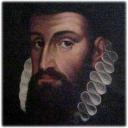
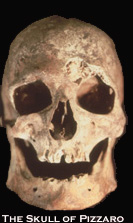
Lima (1 Day) The Plaza de Armas, Francisco Pizarro’s Statue, Pizarro’s Remains, Cerro San Cristóbal
The Strange Missing Skeleton of Francisco Pizarro
Although many tourists stay in Miraflores, one of Lima’s upscale and more modern suburbs on the coast, the most interesting area of Lima from a historical and visual point of view is its original center, built around the Plaza de Armas. Lima’s colonial downtown area, in fact, was declared a World Heritage Site by UNESCO in 1988. This is the original square that Francisco Pizarro outlined in the barren sand in 1535, just a block south of the Rimac River, when he was 57 years old, and it was on this square (on its western side, across from the Cathedral) that Pizarro had his house built—and where he was later assassinated. The plaza is now fronted by the Palacio del Gobierno, on the same site where Pizarro built the first government palace; this is where the current Peruvian President lives.
On the eastern side of the square looms the cathedral, destroyed in a massive earthquake in 1746 and rebuilt on the same site during the following decade. In one of the apses of the cathedral lie Pizarro’s remains. In the distance (to the northeast) on the other side of the Rimac River, one can still see (and visit) the looming San Cristobal hill (Cerro San Cristóbal), where the Inca general Quispe and his army once camped during their assault on the fledgling capital, defended by Pizarro and roughly 100 of his desperate men…
(more…)
The Last Days of the Incas’ Peru Tour #2 (Lima)
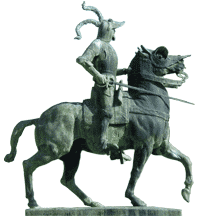
Lima (1 day) The Plaza de Armas, Francisco Pizarro’s Statue, Pizarro’s Remains, Cerro San Cristóbal
Most visitors spend little if any time in Lima, Peru’s capital of 10 million; it’s crowded, noisy, not visually dramatic, and is for a good part of the year (June through December) covered in a thin haze of garua, or fog. However, even a day spent there can be rewarding in terms of visiting some of the sites described in The Last Days of the Incas, and when the sun is out and you are eating a fine plate of ceviche (raw fish “cooked” in lemon juice) in a seaside restaurant, Lima can be a very pleasant place indeed.
Whereas the Lima coastal area was settled for thousands of years before the Incas conquered this area, the actual city of Lima was actually founded by Francisco Pizarro in 1535, shortly before the Incas rose up massively against his rule. It was here, in 1536, that the Inca Emperor Manco Inca’s finest general, Quiso, led an army against Pizarro and 100 of his Spaniards that nearly wiped out the last Spaniards in Peru. It was here, in 1541, that Pizarro was assassinated and it is still here, in the Cathedral on the Plaza de Armas, that Pizarro’s bones are kept in a crypt, more than four centuries after his assassination. They are still scarred by his assassins’ swords and daggers…
(more…)
The Secrets of Machu Picchu

The first major exhibition devoted to the Incas’ fabled cold-weather retreat highlights Machu Picchu’s secrets
(This is a good article on both Machu Picchu and also on the recent traveling exhibit in the U.S. of Hiram Bingham’s Machu Picchu artifacts that Peru is currently trying to get Yale University to return–KM)
By Fergus Bordewich
Smithsonian, March 2003
Although I had seen many images of Machu Picchu, nothing prepared me for the real thing. Stretching along the crest of a narrow ridge lay the mesmerizing embodiment of the Inca Empire, a civilization brought to an abrupt and bloody end by the Spanish conquest of the 1500s. On either side of the ruins, sheer mountainsides drop away to the foaming waters of the Urubamba River more than a thousand feet below. Surrounding the site, the Andes rise in a stupendous natural amphitheater, cloud-shrouded, jagged and streaked with snow, as if the entire landscape had exploded. It is hard to believe that human beings had built such a place. It was more difficult still to grasp that Machu Picchu remained unknown to the outside world until the 20th century…
(more…)
The Last Days of the Incas’ Peru Tour #1

A Self-Guided Companion Tour to the Book
Covering: Lima, Cuzco, the Sacred Valley (Pisac & Ollantaytambo), Machu Picchu, the Inca Trail, and Vilcabamba
Since the publication of The Last Days of the Incas a number of readers have written me asking about how they might visit some of the major Inca cities and locations described in the book. They’ve asked me for recommendations on where and when to go, how long to take, etc.
For those who would like to visit Peru on their own and are interested in planning a trip to Peru and to see for themselves where portions of this epic story actually unfolded, I’ve put together something I call “The Last Days of the Incas’ Peru Tour.” If you have one week, two weeks, three weeks (or more) at your disposal and want to follow your own independent itinerary, then the following information will help guide you to some of the major locations where Francisco Pizarro and his men clashed with the Incas, where Manco Inca launched his guerrilla war, where Pizarro and some of his conquistadors are buried, and where the more recent discoveries of Machu Picchu by Hiram Bingham and Vilcabamba by Gene Savoy took place…
(more…)











